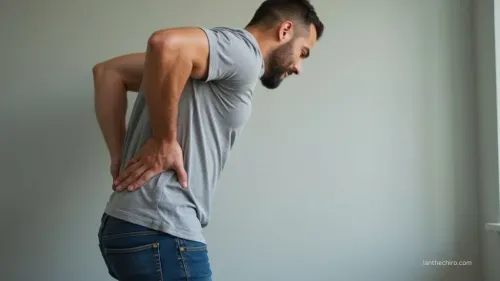L5-S1 Disc Bulge, Slip Disc, Stenosis & Spondylolisthesis
You're dealing with an L5-S1 disc bulge, slipped disc, spinal stenosis, or spondylolisthesis, and the path to relief involves understanding your condition and pursuing a holistic, non-invasive approach. Focus on spinal alignment through chiropractic care, core strengthening, and ergonomic adjustments.
Techniques such as chiropractic care, dry needling, and proper nutrition can also alleviate pain & improve spinal health. Avoid heavy lifting and poor posture to prevent further strain. Consulting healthcare professionals for a personalised plan is essential. Discover more about how to effectively manage and relieve your symptoms.
Understanding L5-S1 Disc Bulge

Chiropractic care is a cornerstone of managing this condition. Through targeted exercise routines, you can strengthen the muscles supporting your spine, promoting spinal alignment and reducing pressure on the affected disc. Your therapist might incorporate stretches and strengthening exercises tailored to your condition, enhancing your recovery process.
Pain management doesn't always mean medication. Techniques like heat and cold therapy, electrical stimulation, and massage can alleviate pain and improve function. These methods work together to reduce inflammation and enhance blood flow, aiding the healing process.
The recovery process can be gradual, but with consistent effort, you can achieve significant improvement. Incorporating specific exercise routines into your daily life helps maintain spinal health and prevent future issues.
Always listen to your body and consult with healthcare professionals to tailor a plan that works best for you.
Causes of L5-S1 Issues

Understanding the causes of L5-S1 issues is essential for maintaining spinal health and alignment. You might face problems like a disc bulge or spondylolisthesis due to degenerative disc disease, traumatic spinal injuries, or repetitive strain factors. By addressing these root causes, you can take proactive steps to support a healthy, pain-free spine.
Degenerative Disc Disease 🦴
As the spine ages, the intervertebral discs, particularly at the L5-S1 level, often undergo wear and tear, a condition known as degenerative disc disease. To manage this effectively, adopting a holistic approach that focuses on spinal alignment and non-invasive treatments is essential.
Regular exercise benefits your spine by strengthening core muscles, which support the lower back and help maintain proper spinal alignment. Gentle exercises like yoga and swimming can be particularly effective.
Nutritional support plays a critical role as well. Consuming a balanced diet rich in vitamins and minerals can promote disc hydration and overall disc health. Staying hydrated guarantees that your discs retain their elasticity and cushioning properties, which can help prevent further degeneration.
Posture correction is another important component. Maintaining proper posture whether sitting, standing, or lifting can reduce strain on the L5-S1 segment and improve spinal alignment. Ergonomic chairs and correct lifting techniques can make a significant difference.
A holistic approach to managing degenerative disc disease at L5-S1 not only alleviates pain but also promotes long-term spinal health. By focusing on exercise, nutrition, and posture, you can slow down degenerative changes and improve your overall quality of life.
Traumatic Spinal Injuries 🚑

Injuries to the spine, particularly at the L5-S1 level, often stem from traumatic events like car accidents, falls, and sports mishaps. These incidents can cause significant damage, leading to conditions such as disc bulges, slip discs, stenosis, and spondylolisthesis. When you experience sudden impact or excessive force, your lumbar spine is at risk for fractures and dislocations, which contribute to spinal instability and nerve compression.
By understanding the mechanisms of traumatic spinal injuries, you can focus on impact prevention strategies to protect your lower back. Trauma management is vital for minimising damage and promoting recovery. Immediate and appropriate responses can prevent further complications like soft tissue damage and the exacerbation of existing conditions.
Fractures and dislocations at the L5-S1 level often require a detailed, non-invasive approach to restore spinal alignment and function. Techniques like physical therapy and chiropractic care can help manage trauma and alleviate symptoms.
Ensuring proper spinal alignment and stability can mitigate nerve compression, enhancing your overall well-being.
Repetitive Strain Factors 🔁
While traumatic events can instantly damage the spine, repetitive strain factors gradually wear down the L5-S1 segment, leading to severe issues. Poor posture, heavy lifting, and prolonged sitting are some of the culprits. Daily activities involving bending, twisting, and lifting without proper body mechanics strain the L5-S1 segment over time, contributing to disc bulges and herniations.
To counteract these effects, ergonomic adjustments in your workspace are essential. Ensuring your chair and desk promote good posture can substantially reduce strain. Postural correction, such as standing tall with shoulders back, also helps maintain spinal alignment and prevent further degradation.
Core strengthening is another critical aspect. A strong core provides better support for your spine, reducing the risk of injury. Incorporate exercises that target your abdominal and back muscles into your routine. Movement modifications, like bending at the knees instead of the waist, can prevent undue stress on the lower back.
Lastly, don't underestimate the power of stretching exercises. Regularly stretching your hamstrings, hip flexors, and lower back can improve flexibility, further protecting the L5-S1 region. Adopting these holistic, non-invasive strategies can help you manage and prevent L5-S1 issues effectively.
Symptoms of L5-S1 Disc Herniation

When experiencing L5-S1 disc herniation, you'll likely notice a variety of symptoms that can impact your daily life and overall well-being. These symptoms often include:
- Sharp lower back pain that may radiate to your buttocks and legs.
- Numbness or tingling sensations in your legs or feet.
- Weakness in your legs, making walking difficult.
- Pain that worsens with movement, coughing, or sneezing.
- Rare but severe cases may involve bowel or bladder dysfunction, requiring immediate medical attention.
Pain and Discomfort 😖
Experiencing an L5-S1 disc herniation can be extremely debilitating, as it often triggers substantial pain and discomfort in the lower back, buttocks, and legs. Managing pain is vital to improving your quality of life. You might find that certain coping strategies, like mindfulness and gentle stretching, help alleviate some of the discomfort.
Chiropractic care plays a pivotal role in addressing this condition, focusing on exercises that promote spinal alignment and reduce nerve compression.
Lifestyle changes can also make a noteworthy difference. Maintaining a healthy weight and practising good posture support your spine and lessen the strain on your lower back. Incorporating core-strengthening exercises into your routine helps stabilise the spine, reducing pain over time.
Having a support system is essential. Friends, family, or support groups can offer emotional encouragement and practical advice, making your journey to recovery smoother. Remember, you don't have to face this alone. Seeking holistic approaches that include non-invasive treatments can notably improve your symptoms and overall well-being.
Numbness and Tingling 🦵
Numbness and tingling in the buttocks, legs, or feet often arise from nerve compression due to an L5-S1 disc herniation, signalling that your spinal health needs immediate attention. These sensations, often described as a "pins and needles" feeling, indicate nerve irritation caused by the disc bulge pressing on nerve roots.
The numbness and tingling can be intermittent or constant, affecting your daily activities and overall quality of life. Addressing these symptoms promptly is vital to prevent potential complications such as permanent nerve damage. A holistic approach focusing on spinal alignment can offer non-invasive treatment options aimed at relieving nerve compression and irritation.
Physiotherapy, chiropractic adjustments, and targeted exercises can help realign your spine, reducing pressure on the affected nerves. Additionally, anti-inflammatory medications and nerve pain blockers can assist in managing symptoms. In severe cases, surgical interventions might be necessary to decompress the affected nerves and restore function.
Weakness in Legs 😫
Leg weakness often signals a disruption in spinal alignment, particularly in cases of L5-S1 disc herniation. When the disc at this level bulges or herniates, it can compress the nerves that control your leg muscles. This nerve compression leads to muscle weakness, making it hard to perform everyday activities.
Leg numbness and tingling are also common, as these sensations accompany the weakness caused by compromised nerve function. You might notice reflex loss, especially in your knees or ankles, indicating nerve root compression. This loss of reflexes can be a clear sign that the nerves are struggling to send signals effectively.
Prolonged nerve compression can lead to an atrophy risk, causing the muscles in your legs to shrink and weaken further. This muscle atrophy not only affects strength but also your overall mobility and balance. Walking difficulty becomes apparent, as the weakened muscles and disrupted nerve signals affect your gait and stability.
A holistic approach focusing on spinal alignment and non-invasive treatments can help manage these symptoms. Techniques like chiro care, gentle chiropractic adjustments, and targeted exercises can alleviate pressure on the nerves, improve muscle strength, and enhance your overall quality of life.
Radiating Pain Symptoms ⚡
Radiating pain from an L5-S1 disc herniation often starts in the lower back and extends through the buttocks and down the legs. This pain can be sharp, shooting, or electric-like, making daily activities challenging. You might also experience numbness, tingling, or burning sensations in the affected leg, which can greatly impact your quality of life.
Nerve compression at the L5-S1 level is a primary cause of these symptoms, leading to both pain and mobility issues. As the nerve gets irritated or compressed, it may cause weakness in the leg muscles, making it difficult to walk or stand for extended periods. Effective pain management and restoring mobility are vital in addressing these symptoms.
Holistic treatment options include chiro care, which focuses on spinal alignment and strengthening the muscles supporting your lower back. Physical therapists can guide you through exercises aimed at reducing nerve compression and improving your overall spinal health.
Additionally, non-invasive treatments such as chiropractic adjustments and acupuncture can complement your pain management strategy.
Diagnosing L5-S1 Conditions

An in-depth diagnosis of L5-S1 conditions often starts with advanced imaging tests, such as MRI or CT scans, which provide detailed visuals of disc bulges, herniations, and any narrowing of the spinal canal. These imaging techniques are essential for identifying the structural issues affecting your spine, ensuring a clear understanding of what's causing your pain.
In addition to imaging, neurological assessments play a critical role. These evaluations examine your reflexes, sensation, and muscle strength, helping pinpoint any nerve involvement.
The clinical history evaluation is also important, where you'll discuss symptoms like back pain, sciatica, leg numbness, and weakness. This conversation helps your healthcare provider understand the impact of your L5-S1 condition on your daily life.
Diagnostic injections, such as selective nerve root blocks or facet joint injections, can also be used to identify the specific source of pain. These injections not only help in diagnosis but can also provide temporary relief.
Non-Surgical L5-S1 Treatment Options at Ian The Chiro

At Ian The Chiro, you can explore non-surgical treatment options like chiropractic adjustments, dry needling, and lifestyle modifications to address your L5-S1 issues.
These holistic methods focus on realigning your spine, reducing pain, and improving your overall well-being without invasive procedures.
Chiropractic Adjustments
For individuals experiencing L5-S1 disc bulge, slipped disc, or stenosis spondylolisthesis, chiropractic adjustments offer a non-invasive path to relief. At Ian The Chiro, the focus is on restoring spinal alignment to alleviate nerve compression and enhance mobility. By targeting the L5-S1 region, chiropractic care can improve your range of motion and support the body's natural healing processes.
Chiropractic adjustments at Ian The Chiro are designed to correct spinal misalignments, which can reduce the pressure on affected nerves significantly. This reduction in nerve compression often leads to a decrease in pain and discomfort, allowing you to move more freely. The holistic approach ensures that your entire spine is considered, promoting overall spinal health and function.
In addition to spinal manipulations, treatments may include mobilisations and therapeutic exercises tailored to your specific condition. These methods not only help with immediate pain relief but also contribute to long-term mobility improvement. By enhancing the range of motion, chiropractic care supports your journey towards a more active and pain-free life.
Dry Needling
While seeking non-surgical treatment options for L5-S1 issues, you might consider the benefits of dry needling offered at Ian The Chiro.
This technique involves inserting thin needles into trigger points or tight muscles around the L5-S1 region to provide muscle relaxation and pain relief. By targeting specific areas of pain or dysfunction, dry needling can improve your range of motion and promote healing in the affected area.
Dry needling works by releasing muscle tension and reducing inflammation, which are essential for alleviating the discomfort associated with L5-S1 disc bulges, slip discs, stenosis, and spondylolisthesis. By stimulating your body's natural healing response, this method offers a holistic approach to managing your spinal health without relying on medication.
At Ian The Chiro, dry needling is part of a broader strategy aimed at improving your overall spinal alignment and well-being.
This non-invasive technique not only addresses the immediate symptoms but also contributes to long-term recovery and prevention of future issues. Choosing dry needling could be a critical step towards achieving lasting relief and enhanced quality of life, all while maintaining a drug-free, holistic approach to your health.
Lifestyle Modifications

Building on the benefits of dry needling, it's essential to check out how lifestyle modifications can complement your treatment plan for L5-S1 issues at Ian The Chiro. Focusing on weight management is pivotal, as maintaining a healthy weight reduces the strain on your lower back. Integrating core strengthening exercises into your routine will fortify the muscles supporting the L5-S1 region, enhancing spinal stability.
Practising proper ergonomics in your daily activities can prevent the exacerbation of symptoms. Confirm your workstation is ergonomically sound, with your chair and screen positioned to promote a neutral spine. Regular stretching is another essential component. Taking breaks to stretch throughout the day can alleviate pressure on the L5-S1 joint and improve flexibility.
Healthy posture is key to promoting spinal alignment and reducing discomfort. Be mindful of your posture whether you're sitting, standing, or sleeping. Avoid prolonged periods in one position, and make it a habit to shift and move regularly. By incorporating these lifestyle modifications—weight management, core strengthening, proper ergonomics, regular stretching, and healthy posture—you can achieve a holistic, non-invasive approach to managing L5-S1 issues effectively. At Ian The Chiro, these strategies form an integral part of your all-encompassing care plan.
Surgical L5-S1 Treatment Options
Surgical treatment choices for L5-S1 disc bulge, slipped disc, stenosis, and spondylolisthesis are carefully tailored to each patient's specific needs and often involve a combination of techniques to restore spinal alignment and alleviate symptoms. Minimally invasive procedures are frequently preferred as they reduce surgical risks and promote quicker recovery. These techniques, such as decompression and fusion, aim to relieve nerve compression and stabilise the spine.
Post-operative care is vital for a successful recovery. You'll need to follow a structured plan that includes pain management and wound care. Rehabilitation exercises play a crucial role in rebuilding strength and flexibility, ensuring long-term outcomes are positive and sustainable. Your surgeon will typically recommend a personalised exercise regimen to help you regain mobility and prevent future complications.
While surgical options can be highly effective, it's important to be aware of potential surgical risks, including infection, nerve damage, or complications related to anaesthesia. However, with advancements in surgical techniques and a focus on minimally invasive methods, these risks are greatly reduced.
Preventative Measures at Ian The Chiro

At Ian The Chiro, we emphasise a holistic approach to spinal health by incorporating several key preventative measures aimed at reducing the risk of L5-S1 disc issues. Core strengthening is fundamental in supporting your lumbar spine, which can notably decrease the likelihood of disc bulges and herniations. Engaging in exercises that target your core muscles will provide the necessary stability and support for your lower back.
Understanding proper lifting techniques is another critical preventative step. By practising correct body mechanics during daily activities, you can avoid injuries that might lead to L5-S1 disc problems. Always bend at the knees and keep your back straight when lifting objects.
Incorporating regular stretching routines into your day can help maintain flexibility and spinal health. These exercises will keep your muscles and ligaments supple, reducing the risk of developing L5-S1 issues.
Weight management is also essential. Maintaining a healthy weight through a balanced diet and regular exercise can reduce unnecessary strain on your lumbar spine, decreasing the risk of disc degeneration.
Lastly, seeking regular chiropractic care maintains your spine stays aligned. Chiropractic adjustments can prevent misalignments that might contribute to disc bulges or herniations, promoting overall spinal health.
Frequently Asked Questions
What Is L5-S1 Disc Spondylolisthesis?
L5-S1 disc spondylolisthesis occurs when your L5 vertebra slips forward over the S1. This misalignment can cause pain and neurological issues. Risk factors include age and spinal stress.
For symptom management, consider non-invasive treatments like rehabilitation exercises. Treatment options range from chiropractic care to surgical procedures for severe cases.
A holistic approach focusing on spinal alignment can help reduce pain and improve function.
What Is the Difference Between Stenosis and Spondylolisthesis?
Stenosis involves spinal canal narrowing, causing symptoms like leg pain and weakness.
Spondylolisthesis is when a vertebra slips forward, leading to back pain and sciatica. Both conditions share risk factors like age and stress injuries.
Treatment options include chiropractic care, which benefits spinal alignment, and surgical interventions for severe cases. Holistic approaches focus on non-invasive methods to manage symptoms effectively.
How Serious Is L5-S1 Disc Bulge?
Approximately 80% of people experience back pain in their lives, with L5-S1 disc bulge being a common culprit. Treatment options include chiropractic treatment, which helps restore spinal alignment and strength. Recovery time varies, but holistic, non-invasive methods often lead to significant improvement.
Long term effects can be minimised with early intervention and proper prevention methods, like maintaining good posture and engaging in regular exercise to support your spine.
What Is the Difference Between a Slipped Disc and a Spondylolisthesis?
A slipped disc occurs when the disc's inner core protrudes outward, causing nerve compression. In contrast, spondylolisthesis involves a vertebra shifting forward. Causes include trauma for slipped discs and vertebral defects for spondylolisthesis. Symptoms can range from pain and numbness to instability.
Diagnosis involves imaging, while treatment focuses on non-invasive methods like chiropractic treatment. Prevention includes exercises for spinal alignment.
Recovery and prognosis depend on early intervention and addressing risk factors to avoid complications.
Conclusion
In managing L5-S1 disc issues, understanding and proactive care are key. Did you know that up to 90% of people with low back pain improve without surgery? With holistic approaches like spinal alignment and non-invasive treatments at Ian The Chiro, you can greatly enhance your quality of life. Don't let pain dictate your days; take charge of your spinal health and explore effective, non-surgical solutions tailored just for you.













